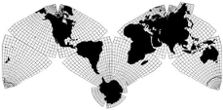
Cahill 1909
|
Go back to
Gene Keyes home page
Cahill-Keyes 1975 |

Cahill 1909
|
Go back to
Gene Keyes home page
Cahill-Keyes 1975 |
|
Why Cahill? What about Buckminster Fuller?
Evolution of the Dymaxion Map: An Illustrated Tour and Critique Part 9.8 by Gene Keyes 2009-06-15 CONTENTS
Click inside boxes to open other sections in separate windows. 9) Critique: Seven Design Flaws of Fuller's
Map as Compared to Cahill's
|
|
Part 9.8
Conclusion
|
Technical notes: These web pages were prepared by Gene Keyes on a very low budget, with old low-end equipment. My second-hand Mac Biege G3 with OS 9.2 is eleven years old, and does yeoman work. Scanning was done with an inexpensive six-year-old HP 1210 printer-copier-scanner. Optical Character Recognition (OCR) was performed with ReadIris 7.0, which was bundled with the HP 1210. Photos of the globes were made without a tripod, using a low-end CX 7500 Kodak digital camera, 3.2 megapixels. Images were handled, cropped, de-bloated*, or resized using Goldberg and/or BigPicture, two freeware programs for Mac OS 9. Some graphics were done with ClarisWorks 5 (Paint, and Draw). Web pages were designed in Netscape 7.01 Composer, and tidied in BBEdit 3.5 and iCab 2.9.9. The click-to-change-picture-size routine (JavaScript) was provided by http://javascript.internet.com/image-effects/enlarge-image-2.html |
As stated in the Disclaimer: All sources have been credited as best I can; this presentation is a labor-of-love, money-losing hobby, aimed at the increase and diffusion of knowledge; i.e., no copyrights have been poached for my commercial use, this being a completely non-commercial, non-profit endeavor by a retired professor living on a shoestring. |
|
Comments, anyone?
Though this is not a blog with space for direct posting, I will be happy to include responses, rebuttals, corrections, and comments if you email them to me: gene.keyes ~~AT~~ gmail.com
as a precaution against gmail's spam-filter, please also send a cc to: gene.keyes63 ~~AT~~ post.harvard.edu or snail mail: Gene Keyes 55 Douglas Ave. Berwick, Nova Scotia B0P 1E0 Canada |